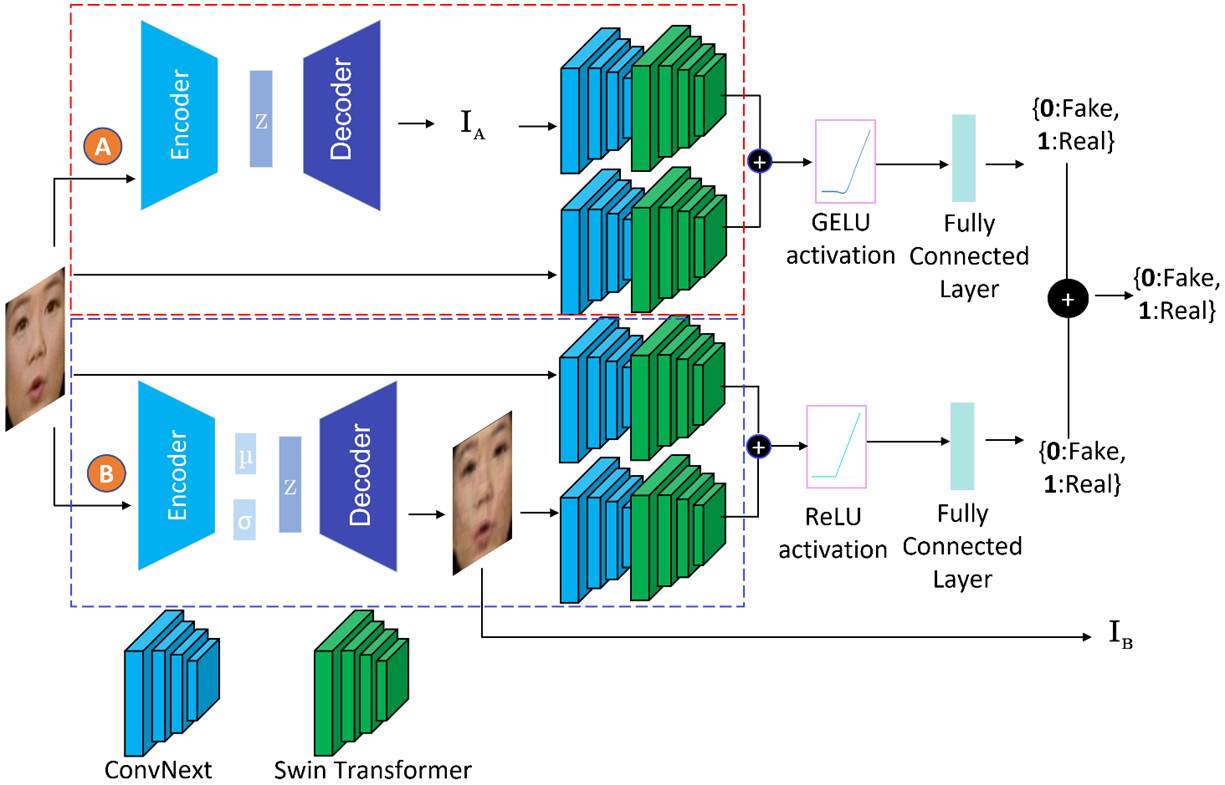Deressa Wodajo, Solomon Atnafu, Zahid Akhtar
This repository contains the implementation code for Deepfake Video Detection Using Generative Convolutional Vision Transformer (GenConViT) paper. Find the full paper on arXiv here.
The Proposed GenConViT Deepfake Detection Framework
Deepfakes have raised significant concerns due to their potential to spread false information and compromise digital media integrity. In this work, we propose a Generative Convolutional Vision Transformer (GenConViT) for deepfake video detection. Our model combines ConvNeXt and Swin Transformer models for feature extraction, and it utilizes Autoencoder and Variational Autoencoder to learn from the latent data distribution. By learning from the visual artifacts and latent data distribution, GenConViT achieves improved performance in detecting a wide range of deepfake videos. The model is trained and evaluated on DFDC, FF++, DeepfakeTIMIT, and Celeb-DF v2 datasets, achieving high classification accuracy, F1 scores, and AUC values. The proposed GenConViT model demonstrates robust performance in deepfake video detection, with an average accuracy of 95.8% and an AUC value of 99.3% across the tested datasets. Our proposed model addresses the challenge of generalizability in deepfake detection by leveraging visual and latent features and providing an effective solution for identifying a wide range of fake videos while preserving media integrity.
The GenConViT model consists of two independent networks and incorporates the following modules:
Autoencoder (ed),
Variational Autoencoder (vae), and
ConvNeXt-Swin Hybrid layer
The code in this repository enables training and testing of the GenConViT model for deepfake detection.
* Python 3.x
* PyTorch
* numpy
* torch
* torchvision
* tqdm
* decord
* dlib
* opencv
* face_recognition
* timm
- Clone this repository:
git clone https://github.com/erprogs/GenConViT- Install the required dependencies:
pip install -r requirements.txtTo train the GenConViT model, follow these steps:
- Prepare the training data, or use the sample training data provided:
- Ensure that the training data is located in the specified directory path.
- The training data should be organized in the required format. The
fakedirectory contains images that are fake, while therealdirectory contains images that are real.
train:
- fake
- real
valid:
- fake
- real
test:
- fake
- real
- Run the training script:
python train.py
-d <training-data-path>
-m <model-variant>
-e <num-epochs>
-p <pretrained-model-file>
-b <batch-size>
-t<training-data-path>: Path to the training data.
<model-variant>: Specify the model variant (ed for Autoencoder or vae for Variational Autoencoder).
<num-epochs>: Number of epochs for training.
<pretrained-model-file> (optional): Specify the filename of a pretrained model to continue training.
-b (optional): Batch size for training. Default is 32.
-t (optional): Run the test on the test dataset after training.
The model weights and metrics are saved in the weight folder.
Example usage:
python train.py --d sample_train_data --m vae -e 5 -t ypython train.py --d sample_train_data --m ed --e 5 -t yDeepfake Detection using GenConViT
To make prediction using the trained GenConViT model, follow these steps:
- Download the pretrained model from Huggingface and save it in the
weightfolder.
Network A (ed)
wget https://huggingface.co/Deressa/GenConViT/resolve/main/genconvit_ed_inference.pthNetwork B (vae)
wget https://huggingface.co/Deressa/GenConViT/resolve/main/genconvit_vae_inference.pthJust to save you from a surprise :)
The provided weights only include the state dictionary. This means that the size of the provided weights is approximately half of what you would get if you trained the model yourself. For example, while the VAE is typically between 5GB and 7GB, the provided one is 2.6GB.
- Run the prediction script:
To run the code, use the following command:
python prediction.py \
--p <path-to-video-data> \
--f <number-of-frames> \
--d <dataset> \
--e <ed-model-weight-name-(without .pth)> \
--v <vae-model-weight-name-(without .pth)> \
--fp16 <half-precision><path-to-video-data>: Path to the video data or [ dfdc, faceforensics, timit, celeb ].
<number-of-frames>: Specify the number of frames to be extracted for the video prediction. The default is 15 frames.
<model-variant>: Specify the model variant (ed or vae or both:genconvit).
<dataset>: the dataset type. [ dfdc, faceforensics, timit, celeb ] or yours.
<half-precision>: Enable half-precision (float16).
Example usage:
python prediction.py --p DeepfakeTIMIT --d timit --f 10 To use VAE or ED variant:
VAE:
python prediction.py --p sample_prediction_data --v --f 10
ED:
python prediction.py --p sample_prediction_data --e --f 10
VAE test on DeepfakeTIMIT dataset:
python prediction.py --p DeepfakeTIMIT --v --d timit --f 10
run VAE and ED (GENCONVIT): this runs the provided weights as a defualt
python prediction.py --p sample_prediction_data --e --v --f 10
Testing a new model:
If you have trained a new model (e.g., if we have weight/genconvit_vae_May_16_2024_09_34_21.pth) and want to test it, use the following:
VAE:
python prediction.py --p sample_prediction_data --v genconvit_vae_May_16_2024_09_34_21 --f 10
ED:
python prediction.py --p sample_prediction_data --e genconvit_ed_May_16_2024_10_18_09 --f 10
BOTH VAE and ED (GENCONVIT):
python prediction.py --p sample_prediction_data --e genconvit_ed_May_16_2024_10_18_09 --v genconvit_vae_May_16_2024_09_34_21 --f 10
The results of the model prediction documented in the paper can be found in the result directory.
python result_all.py@misc{wodajo2023deepfake,
title={Deepfake Video Detection Using Generative Convolutional Vision Transformer},
author={Deressa Wodajo and Solomon Atnafu and Zahid Akhtar},
year={2023},
eprint={2307.07036},
archivePrefix={arXiv},
primaryClass={cs.CV}
}This research was funded by Addis Ababa University Research Grant for the Adaptive Problem-Solving Research. Reference number RD/PY-183/2021. Grant number AR/048/2021.
